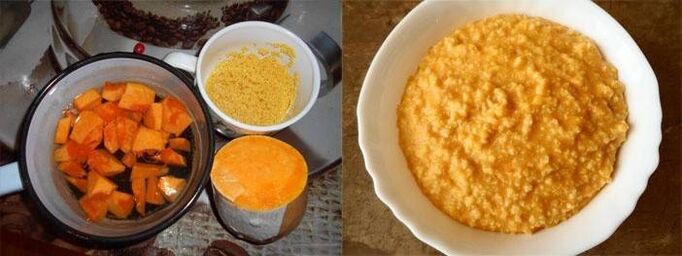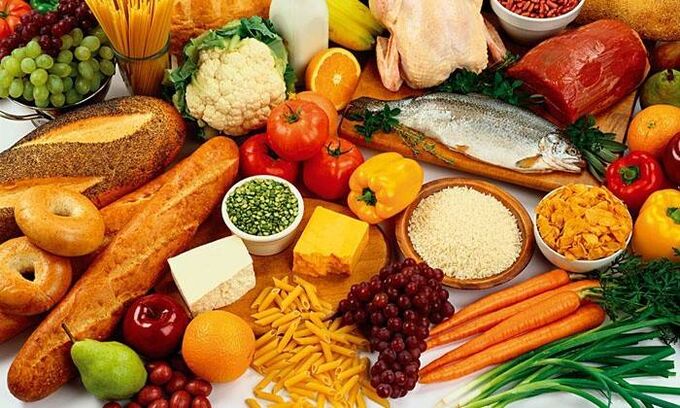Psoriasis is a dermatologically non-communicable disease that is rapidly becoming chronic. During the exacerbation of psoriasis, crumbly, protruding rashes appear on the surface of the skin, which is very disturbing. Typical areas of psoriasis are the knees, elbows, and scalp. The disease spreads throughout the body. A diet for psoriasis can alleviate the course of the disease. According to statistics, 70% of patients are under 20 years old, but absolutely all age groups are prone to psoriasis.
Eating rules for psoriasis
The diet for psoriasis is a medical food that is recommended to be followed to prevent relapses in the patient. Patients with psoriasis should monitor their emotional state, monitor the functioning of the stomach and the entire gastrointestinal tract, eat small doses (at least five times a day), eliminate allergens and increase the amount of fluid consumed. Daily stool is an unshakable rule for psoriasis patients. Food stagnation in the body helps aggravate psoriasis.

To maintain proper water balance in psoriasis:
- For 1, 7-2 liters of purified water with the addition of a small amount of lemon juice daily.
- Reduces consumption of black and green teaIncrease the amount of herbal infusions, especially chamomile, flaxseed decoction.
- Include fresh juices (carrots, spinach, celery, apples, parsley, beets) in the diet.
Basic eating rules for psoriasis:
- Remove fried and fatty foods from the menu. A special place are boiled dishes cooked or baked in the dining table.
- Reduce the amount of salt.
- Increase fermented dairy products, preferably home-made products.
- Limit the variety to your meals. Replace them with lemon juice or a specially prepared sauce (yogurt + herbs + garlic + mustard) for health benefits.
What can psoriasis patients eat and not eat?
Diet for psoriasis involves full control and adherence to the basic rules of a healthy diet. There are few people who can limit themselves and give up their favorite foods, but in the period of exacerbation of psoriasis - this is a difficult necessity. The disease is not completely cured. The course cannot be changed by medication alone and without following dietary treatment. Information on which foods should be completely eliminated during psoriasis exacerbation can alleviate the patient's well-being and reduce the underlying symptoms.
List of allowed and prohibited products
With psoriasis you should follow these dietary rules:
- Eat more greens (lettuce, parsley, dill, green onions), fresh fruits and vegetables. It all has a vitamin store.
- Eat oily fish (salmon, salmon) more often boiled or steamed.
- Eat heavy porridge - buckwheat, rice, oatmeal, wheat or something else.
- Add PUFA vegetable oil to the dish.
- Saturate your diet with lingonberries or blueberries. These small balls have long been considered a leader among fruits to relieve the symptoms of psoriasis.

People with such a disease should be strictly excluded from the diet or reduced:
- Coffee consumption, strong teas.
- The amount of fatty meat.
- The amount of alcohol.
- Consumption of spicy or salty spices, vinegar.
- The amount of honey, sugar, baked goods.
- The share of strong meat broths and sauces in the diet.
- Eat any smoked product.
Sample menu for a week
By compiling a diet menu for a week (5 days), it is easier to see which foods to buy and to avoid emergency snacks with foods that are forbidden for psoriasis. Diet is important in the treatment of psoriasis. Failure to do so will aggravate the disease. Remember to drink 1 glass (or more) of purified cool water between meals. Dinner should be three hours before bedtime.
Monday
- Breakfast - buckwheat porridge + a small piece of butter + dried fruit. Weak tea with a slice of hard cheese.
- 2nd breakfast (after 2 hours) - apples, bananas or other fresh fruits that do not cause allergies.
- 3rd breakfast (after 2 hours) - low-fat sour cream + cottage cheese with fruit.
- Lunch - salad (fresh vegetables + a tablespoon of olive oil), vegetable soup, bread with a piece of low-fat boiled meat.
- Afternoon snack - fruit.
- Dinner - baked vegetable porridge + bread. After 1, 5 hours low-fat kefir + biscuits.
Tuesday
- Breakfast - raisins and oatmeal with a piece of butter, bread, 1 cup hips drink.
- 2nd breakfast - low-fat kefir.
- 3rd breakfast - fresh fruit.
- Lunch - salad (dressing with fresh vegetables, olive oil and lemon juice). Second chicken soup. Mashed with a slice of steamed fish. Bread.
- Afternoon snack - fresh fruit curd, seasoned with yogurt.
- Dinner - wheat porridge without meat + steamed vegetables.
Wednesday
- Breakfast - an omelet with two eggs. Cocoa, butter and hard cheese sandwich.
- 2nd breakfast - fresh fruit.
- 3rd breakfast - a glass of kefir.
- Lunch - fresh vegetable salad + salad dressing (greens, mustard, lemon juice, olive oil, garlic). Borscht with beef broth. Rice porridge with steamed cutlets. Bread.
- Afternoon snack - a few baked apples.
- Dinner - vegetable casserole. A piece of rye bread.
Thursday
- Breakfast - low-fat cottage cheese seasoned with sour cream + grapes. A glass of freshly squeezed juice.
- 2nd breakfast - fresh fruit. Compote with dried fruits.
- 3rd breakfast - 1 boiled egg.
- Dinner - ears. Steamed chicken cutlets + vinaigrette. Bread. Herbal chamomile tea
- Afternoon snack - dried fruit compote. Chocolate-free marshmallows.
- Dinner - steamed salmon + oatmeal with a piece of butter. Bread. Weak green tea.
Friday
- Breakfast - pumpkin milk porridge with dried apricots and raisins. Bread. Compote with dried fruits.
- 2nd breakfast - freshly squeezed juice + 2 scrambled eggs.
- Lunch - pumpkin puree. Rice, unfried. Bread. Rosehip decoction.
- Afternoon snack - a glass of yogurt (fermented baked milk or kefir) + two baked apples.
- Dinner - cottage cheese casserole. Compote or chamomile tea.
Diet recipes
Curd cheese casserole
Prepare 1 kg of low-fat cottage cheese + 4 eggs + 1 cup semolina + half a cup of steamed raisins + 5 tbsp. l. sugar + a pinch of salt and vanilla. Rub the cottage cheese through a sieve, add beaten eggs with sugar and mix. Pour semolina, salt and vanilla into the curd mass. Mix with a spoon or blender, let stand for half an hour. Put the resulting mass in a greased form. Cook with or without lid (at medium temperature for about half an hour). Allow the casserole to cool before use. A healthy dessert is ready for the duration of the diet.
Pumpkin porridge with raisins is a healthy dessert for psoriasis

You will need: half a kilogram of pumpkin, 2/3 cup of rice, half a liter of milk, half a cup of raisins, salt, sugar, vanilla to taste. Peel a squash, grate it and squeeze the juice. Cut into small cubes or strips. Pour in half with water. When soft, knead well, pour the milk. Add cooked rice (soak 2 hours before, rinse), salt, sugar. Pour the washed raisins and vanilla 15 minutes before turning off. Add a piece of butter to the prepared porridge. Put in the oven for 15 minutes - the dish will be more aromatic and delicate.
Zucchini soup with hard cheese
To make a delicate spring soup, you will need:
- 1 liter of purified water;
- 2 pumpkins (up to 20 cm long);
- 5 potatoes;
- 1 teaspoon grated ginger root;
- hard cheese (1 osh spoon l per serving);
- 1 tbsp. l. olive oil;
- fresh or dried herbs (parsley, dill, celery);
- salt to taste;
- spices (bay leaf, cardamom).
Pour the chopped potatoes and pumpkin into boiling water. Pass the crushed coriander with a mortar, grated ginger for 30 seconds. Put in the prepared vegetables, boil for 1 minute, turn off the heat. Drain the excess liquid in a separate container. Grind the boiled vegetables in a blender, add the vegetable juice until the desired consistency is achieved. Add salt and herbs. Bring to a boil, turn off. Sprinkle the soup-puree, lined with serving plates, with grated hard cheese to taste. The first meal is ready for the patient's diet.
Oatmeal with dried fruits
Useful for psoriasis, a quick meal oatmeal. You should take half a cup of oatmeal. Pour them into boiling water (1 cup), add raisins, dried apricots or other dried fruits (any fresh or frozen fruit), salt, sugar to taste. Extinguish the fire. Add a piece of butter. Infuse for 15 minutes. The diet is ready for breakfast or dinner.
Principles of nutrition therapy according to different methods
A common diet for treating psoriasis patients is the Pegano method. Two nutritionists agree that psoriasis patients need to maintain an acid-base balance of 20-70% or 30-80% and follow the basics of proper nutrition to prevent recurrence and worsening of the condition. Consider both diets.
According to the Pegano method
Dr. John Pegano has developed a dietary treatment for psoriasis patients in which vegetables and fruits are grouped to help regulate acid-base balance. It is believed that raw apples, bananas and melons are consumed in the smallest doses apart from other nutrients. Eat small portions of currants, plums, avocados, beans, cranberries, dried beans, mushrooms, prunes, lentils, ravent, almonds, hazelnuts. It is recommended to take 1 tablespoon five days a week. l. lecithin (granular). There should be a slight feeling of hunger after eating.

Up to 80% of the food consumed in the diet for psoriasis includes:
- purified water (up to 8 cups per day), in addition to other liquids;
- fruits, vegetables, but not canned. Baked apples, dates, apricots, figs, raisins, kiwi, mango, pear are especially useful for patients with psoriasis. Vegetables - asparagus, carrots, cabbage, beets, celery, onions, olives, pumpkin, squash. This is the basis of the diet for psoriasis.
A patient with psoriasis should have about one-third of their diet:
- cereals in the form of grains - buckwheat, millet, oatmeal, barley, rye;
- wholemeal bread, bran, crispy bread, sprouts;
- fish dishes (at least four times a week): tuna, cod, flounder, perch, sturgeon, trout;
- poultry - up to three times a week (without skin);
- meat (lean lamb only) - twice a week;
- skim milk, fermented dairy products, butter, cheese, cottage cheese;
- eggs (boiled or boiled only) - four times a week;
- chamomile, watermelon seeds, mullein mixture.
Treatment of a patient with psoriasis with a diet according to the Pegano method excludes the combination of:
- citrus fruits (not only fresh, but also dried, baked) and whole grains with fruit juices;
- dairy products, juices with citrus fruits;
- all kinds of fruit with white flour products;
- food that forms a large number of acids in a meal.
According to the method of a dietitian
In the treatment of psoriasis with diet, another nutritionist combines food with herbal mixtures. According to his method, the diet completely eliminates all citrus fruits (except grapefruit), strawberries, beans, raspberries, avocados, strawberries, pomegranates, lentils, peas. Allowed grapes (in small quantities), cabbage (any part). It is recommended to consume green beans, squash, carrots, broccoli, garlic, onions, spinach, cucumbers, pumpkin at short intervals. Bananas, melons and raw apples are eaten separately from other foods. They drink mineral water every day.























